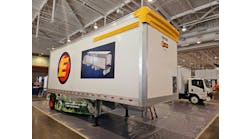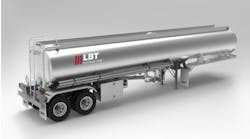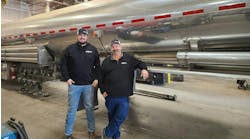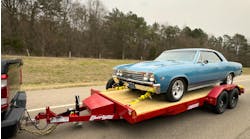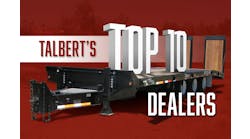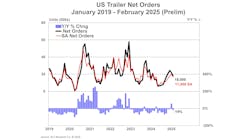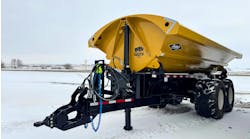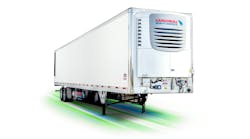Atlanta. In the rapidly developing, fully connected, seamless and transparent supply chain, trailers will still carry the bulk of North America’s freight, but they’ll also be delivering critical data.
“Smart trailer technology is beginning to redefine the capability of trailers,” said Paul Menig, transportation industry veteran and a technology specialist. “It’s going to be more than just a box in which goods are hauled. Smart trailers are becoming mobile treasure troves of data containing information on many different aspects of the freight logistics process and the trailer itself.”
Menig moderated a panel at the Technology & Maintenance Council’s annual meeting and exhibition dubbed “Smart Trailers: Creating Trucking’s Next Information Superhighway,” which he called “one of the more important sessions” of this year’s TMC.
“Thanks to sensor technology, fleets have new visibility on load monitoring and condition, delivery status, vehicle health, maintenance status, and location,” Menig continued. “They can reduce the need for breakdown maintenance and road repairs, as well as improving CSA compliance, boosting driver productivity and retention of those drivers.”
Smart trailers basically integrate sensor data and collection onboard the trailer from a variety of manufacturers and suppliers, providing the collective information and putting it together into useful, consolidated reports for fleets, Menig explained. Data points can include interior and exterior temperature, door open-status, tire pressure monitoring, ABS events, wheel hub vibration and hub temperature, tire temperature, tire pressure, cargo monitoring, lights-out monitoring, and “honestly just about anything you could imagine for the future.”
He then handed the discussion to a panel representing the development and use of smart trailer technology from the trailer manufacturer to the telematics system supplier to the vehicle diagnostics provider and finally to the end user—the truck fleet.
- From Aaron Wood, trailer management manager at truckload giant US Xpress, Menig asked for the fleet perspective on smart trailers and enhanced maintenance and the impact on cost per mile, as well as any issues pertaining to the implementation of the technology.
- For Wabash Van GM Mark Ehrlich, the question was whether the data generated by connected trailers would benefit the OEMs like the remote diagnostics capability and improved warranty data realized by truck OEMs and their telematics platforms.
- Noregon Chief Technology Officer Dave Covington was tasked with explaining how diagnostics have evolved with engine telematics on the tractor side, and how the raw data is turned into useful operational information for the fleet, both for the operator and the office.
- But exactly how smart are these smart trailers going to be, and how do they work? That was the question for Wally Stegall, technical fellow and director of business development for Morey, which develops and manufactures technologies in the smart connectivity and energy efficiency electronics sectors.
“As we begin this important session, I’d like to remind all of you that we all are in the business of moving product from point A to point B,” Menig said. “What my wife wanted after I ordered an Apple Watch from China was to track this product. She didn’t care what box it was in or what palette it was on. She didn’t care what trailer it was in.
“You might need to think about what you define the trailer to be. The trailer today is a major piece of equipment that is hauling freight. But think more broadly and consider how this discussion pertains to anything that can haul freight—because what we’re going to eventually want to do is track that product, regardless of how it’s delivered.”
Fleet perspective
Even rudimentary smart trailer technology is already paying dividends for fleets. In looking back at the way US Xpress operations have changed since they adopted trailer tracking, Wood reported better control of trailer count and location.
“So we moved into this era now where we’re doing the same amount of business we had been doing and more—but doing it with less,” he said. “Using trailer tracking, we were able to reduce our trailer count over time, and we continue to reduce that count in our older fleet, as we cycle in new equipment.”
Indeed, the fleet reduced its trailer count by 20% in the first 17 months before cycling in new equipment. After two years, and during one of the best operating environments for truckers in years, the trailer count was still reduced by almost 15%.
“We’re able to maintain that trailer count at a very effective level now due to better control of our equipment,” he said.
Additionally, he explained that when he moved from operations to maintenance at US Xpress, he learned early on that “nobody cares about our equipment like our folks.”
“So what we’ve been able to do with the tracking and monitoring of this equipment is get more of our trailers through our shops, to get their preventative DOT maintenance done, rather than paying for somebody else to do it over the road,” Wood said. “And with tracking we know where that equipment is and we’re able to do it easily.”
Similarly, the rate of scheduled outside service fell from 68% in July 2016 to 54% by December 2018, with in-house scheduled service increasing from 32% to 46%, according to US Xpress data.
“As we continue to work to a better process, those lines are slowly coming together,” Wood said. “And hopefully one day I’ll have them crossing.”
Trailer manufacturers
But GPS tracking is only the beginning.
Trailers OEMs must make the transition from being experts in “mechanical innovation” and assembly, to becoming providers of integrated solutions, explained Wabash’s Ehrlich. Traditional trailer specs were focused on the hardware: axles, bearings, doors, brakes, electrical systems, he noted.
“When we look at tomorrow’s specs, or smart specs, they start to sound different; they look different—different considerations, and different expertise,” Ehrlich said. “We’re talking about devices, gateways, networks, analytics, security platforms. And we start to get away from the adage, traditionally, as ‘assembly,’ and we start using the term ‘integrated.’ Like Dell integrates a computer—taking many components, putting them together into a package to aid and serve the customer—in our case, the fleet.
“We’ve got to be ready as trailer OEs. These are different skillsets. My engineer that does the wheel-end assembly is not going to be doing my smart trailer integration. That doesn’t carry over. So that is a perspective we’ve got to gear up for. This is a massive amount of change. And we always want to be in the forefront of moving the industry toward better productivity and efficiency—we don’t want to be in the way of that.”
OEM considerations have moved into the world of IoT, or the internet of things, Ehrlich continued. Decisions have to be made regarding which sensors to use; which communication network; which platform (such as Google or Microsoft, for instance); which software and dashboards; which data processing system to provide the analytics; which cloud storage service; and, “the largest hurdle,” according to Ehrlich’s presentation, how to secure the system.
- In other considerations, decisions must be made regarding:
- Open platform versus a proprietary system, and connectivity between legacy systems;
- Tractor-to-trailer integration, where system-level data requires direct communication between the two—but that becomes “incredibly complex;”
- Trailer ‘birth,’ where OE-level integration offers the lowest cost of installation of the sensors and data bus connectivity required by smart systems technology;
- Monitor versus control, or whether the systems are just being remotely observed or is there an intentional or even inadvertent ability to control aspects of the operation;
- Data ownership and monetization—‘the biggest grab in any industry;’ and
- Unknown risks: “We don’t know what we don’t know.”
“Obviously, for an OE, we’re always trying to make different components talk to each other—to give a system to the user,” Ehrlich said. “So just think of it mechanically, and then think of it from an electronics or technology standpoint. We are going to have to come up with that bridge between all the many systems. We’ve got many different systems already, and we’re having to figure out how to make those work: Where yesterday it was fit-up and tolerance, it now might be protocols and bandwidth.”
Among the challenges trailer manufacturers face, Ehrlich first notes “the network effect.”
“The more devices that you have on the network, the more valuable it is,” he said. “So if we do a pilot of 10 trailers on a fleet of 15,000, there’s not a huge amount of value there—but you do see the pathway. Now you’ve got to think about what to do with the rest of those: When do you start? How do you phase in? It takes some bold moves.”
But bold moves run the risk of selecting the wrong technology, Ehrlich noted.
“This stuff is changing so quickly. I’ve been in the industry professionally for six years, and the change in six years has been enormous,” he said.
Indeed, technology companies from Silicon Valley are looking for opportunities in transportation, but they don’t know the industry. Traditional transportation industry companies, however, don’t know the new technologies.
“What exactly are we trying to do? Is it tracking the Apple Watch, or is it lowering the cost to do the Apple Watch delivery?” Ehrlich said, in noting the challenges of setting the proper scope or product direction. “We’ve got to be clear.”
He also notes the challenge of the “firehose effect,” where “there’s tons of information available” but data isn’t useful unless it actionable.
“So many early adopters of smart technology, they’re just drinking from a firehose,” he said. “‘I’ve got so much data, I can’t actually make a business decision because I can’t decipher it yet.’”
The good news is smart technology provides customer value in a number of segments:
- Compliance, by anticipating downtime or failures before operations are impacted; along with automated weigh station functionality and collision mitigation;
- Operations, as US Xpress has demonstrated, with improved inventory management and utilization;
- Maintenance, with streamlined repair and processes;
- Fuel, by using dynamic tire inflation or platooning; and
- Drivers, through more efficient use of personnel.
Regarding future design, Ehrlich emphasized understanding customer needs has never been more important.
“Knowing what our customers do with the products is paramount—not only to product design, but to our business. That’s what we’re based on,” he said. “And leveraging IoT, knowing how the trailer is being used, increases the accuracy of the problem statement; that can then give us a better chance at getting a creative solution.
“We can all talk about issues anecdotally. But with the data available, I can solve the problem very effectively and very quickly. That absolutely is a must, feedback to the OE—just like the truck industry—that can help in so many ways.”
Smart tech
So just what the heck is a “smart trailer?” That was the launching point for the presentation by Stegall, who first outlined the development of the modern trailer.
“In the beginning, there was the SAE J560, the kingpin and the gladhand,” Stegall said, referring to the fundamental hardware that connects the trailer to the tractor. “And that’s basically where the industry has been for a very, very long time. Everybody knows it works great, and we’ve been happy.
“Then we have ABS brakes come into the marketplace. And the government in its wisdom said that we had to turn the light in the tractor on to give a warning indication. And we got powerline carriers, a marker light on the side of the truck. That was a big change, and I’m sure we all remember how that flowed to the industry.”
Then in the 2000s, track-and-trace devices became ubiquitous, along with some basic load sensing. By 2010 refrigerated carriers had integrated telematics, and fleets were collecting data.
“Very simple, step-by-step organic development,” Stegall said. “And even before ‘smart trailer’ became the hot phrase in the last few years, we had TMS systems, tire inflation systems, door sensors, solar panels, wireless temperature sensors in the trailer, video, cargo sensing—there were a lot of different individual things, but they were not part of an integrated whole.”
But today, as he noted, the TMC exhibition hall had numerous displays featuring attempts at integrated smart trailer telematics systems.
“I’m hoping that we can form a more unified vision, from a topology standpoint with physical layer and protocol,” said Stegall, who serves as second vice chair of the TMC Smart Truck Program. “Everybody who’s got a bar of metal is trying to put a sensor on that bar of metal to provide data. All these various systems need to be interoperable and work together, so that the fleets can spec what they need for their operations.”
Discussing a slide that showed a basic schematic of a smart trailer system, Stegall noted that today’s systems have already “maxed out” the network bandwidth afforded by 125 kB/sec, and suggested that 250 kB/sec should be the minimum moving forward.
“In advance of this [smart trailer] vision coming to full fruition, and to help with what the trailer OEMs are doing and what the fleets want to accomplish, we need to at least agree on a physical layer trunk within the trailer to take all the data in, share it and be able to communicate,” he said. “Because how many wide-area communication systems are you going to have? You’re not going to have two cell phones on your trailer. How many local area systems are you going to have?
“You’re going to have to have a device that will receive multiple sensors that are wireless, and we’ll put that data on the data bus physical layer and give it to the telematics device to store it somewhere to be offloaded. However, what the gateways will become I do not know.”
Stegall also suggested the adoption of SAE JA 6268, a vehicle prognostics standard already in use in the aerospace and automotive industries, would enable the creation and sharing of data and also protect proprietary information.
Diagnostics
Noregon’s Covington cited two diagnostic challenges related to the development of smart trailers:
- Diagnostics are not keeping pace with the rapid adoption of new technology; and
- Lack of oversight in diagnostic standards.
“There are lots of reasons diagnostics have been slow to evolve, but primarily we probably haven’t had the data that we needed in the past all in one place,” Covington said. “Lots of things are driving the technology on the vehicles, from regulated emissions changes to our push for autonomy. So the vehicles are getting super complicated.”
For instance, the average number of ECUs on a truck has risen from two to 15, and the average number of data points has grown from 60 to more than 700. Simply, diagnostics have not evolved at the same rate, he explained.
“Diagnostics is still pretty much the same thing it was when I started 21 years ago,” Covington said. “You get a wall of data, and you get a handful of faults. Then we hand it off to our technicians and say, ‘Go get ‘em, boys. I hope you fix this thing—and, by the way, we need it done quick.’
“We need to do something to utilize all the data that we have to make the technicians more efficient.”
However, ever-improving tools like AI and machine learning are catching up quickly.
“Instead of giving technicians data, we can give them information,” he said. “And we can even be pushing toward the predictive and prognostics.”
As for oversight, Covington related the “success story” of TMC RP1210. Notably, most major diagnostic applications use it, and fleets have pushed compliance.
Covington also touched on communication protocols, noting that current standards provide the means for proprietary messaging. The problem is that a standards-based diagnostics tool cannot read all of the fault codes, meaning that some service providers can’t get the data they need.
“They have to spend days and weeks calling the OEs to try to figure it out,” he said. “And if you want to triage your vehicle, you will either need to have a handful of OE diagnostic tools, so that you can do your serial diagnostics—one for the transmission, one for the engine, one for the brakes—to try to figure out what’s going on that vehicle. Or you can buy an advanced aftermarket tool—again, not a standards-based aftermarket tool.”
As an example of the problem of proprietary data, an all-makes fleet could require up to 30 separate diagnostic apps, Covington noted. Along with cost, multiple apps entail keeping them all updated on multiple PCs in the shop, and training technicians.
In terms of data transfer challenges, proprietary systems are again a problem.
“Many trailer device providers, like the TPMs and reefer systems, have not had an easy way of getting their information off the trailer over to the tractor’s telematics service provider to be sent off,” he said. “There’s a couple of reasons for that. One is that there’s not a common data bus on the trailer for anything other than your ABS-type devices. And the only non-proprietary way to get data from the trailer to the tractor is via the 7-way and using PLC [powerline carrier communications].”
Additional challenges include the absence of a built-in power source on most trailers and, with fleets carrying as many as four trailers per tractor, outfitting trailers with telematics could get expensive.
Covington also notes that, because fleets need to keep their equipment rolling, system updates “typically lag by months” after they’re pushed out. And while over-the-air (OTA) reprogramming is becoming standard, the various manufacturers are limiting access.
“As an industry, I think we need to work together to build a common portal to support all makes, all models for reprogramming. Otherwise, you guys get to get more logins and passwords to more portals—sorry about that,” Covington said, speaking to the crowd of fleet maintenance managers. “Ultimately, our goal for reprogramming should be to have something that’s so automated that we know where the truck’s going, we know what it’s hauling, we know its current state, and we can have a real-time calibration built and deployed to those vehicles so that you get optimal performance.
“Yeah, that’s Nirvana, but maybe we’ll get there.”
